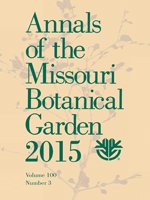Recently, evolutionary relationships among the five major lineages of the basal angiosperms, i.e., Amborellanae, Nymphaeanae, Austrobaileyanae, Magnolianae, and Ceratophyllanae, still remain incompletely or controversially resolved. This study reviews and reevaluates the origin, evolution, and systematic significance of pollen morphology in basal angiosperms. Pollen grains from 34 species of 31 genera in 23 families of the basal angiosperms are investigated, using light microscopy (LM) and scanning electron microscopy (SEM), to illustrate the pollen diversity across the grade. Pollen data for 57 genera, representing all nine orders and 28 families of the basal angiosperms, were obtained from previous work and new investigations and were used to optimize character states onto recent molecular phylogenetic estimates. Two 18-character datasets were generated: a comprehensively coded dataset optimized with Fitch parsimony onto 12 recent phylogenies with differing topologies to evaluate the degree of pollen systematic significance of each topology, and a democratically coded dataset optimized by using Fitch parsimony, maximum likelihood, and hierarchical Bayesian inference onto a single recent phylogeny based on molecular data from Soltis et al. to evaluate the disparity of pollen evolutionary patterns among the three methods. Pollen morphology of the basal angiosperms is highly diverse, particularly in terms of pollen size, aperture number, aperture position, ectoaperture shape, tectum sculpture, and infratectal structure. Based on both datasets, the plesiomorphic pollen type for angiosperms was inferred to comprise monads of heteropolar, spheroidal, mono-apertural grains, with distal, colpate apertures, sculptured aperture membranes, and an infratectum and foot layer. Of the basal angiosperm phylogenies considered, when taxon sampling is taken into account, pollen characters provide greatest support for the topology represented in the three-mitochondrial-gene study from Qiu et al., in terms of number of synapomorphies plus what we term “likely synapomorphies” in which the subtending node is ambiguous and, therefore, the exact position of the synapomorphy is ambiguous. Thirty-six various lineages above family level are supported by pollen morphological synapomorphies or likely synapomorphies. We discuss the systematic significance of pollen morphology in basal angiosperm clades including the ANITA group (Amborellaceae, Nymphaeaceae, Schisandraceae, Trimeniaceae, and Austrobaileyaceae), Ceratophyllales, Chloranthales, and magnoliids, as well as in related lineages, i.e., monocots and basal eudicots. We also discuss present limitations in inferring the evolutionary history of pollen morphology in basal angiosperms.
How to translate text using browser tools
16 March 2015
Evolution of Angiosperm Pollen. 2. The Basal Angiosperms
Lu Lu,
Alexandra H. Wortley,
De-zhu Li,
Hong Wang,
Stephen Blackmore
ACCESS THE FULL ARTICLE
<
Previous Article
|
Amborellales
ancestral character reconstruction
Austrobaileyales
basal angiosperms
Ceratophyllales
character evolution
Chloranthales





